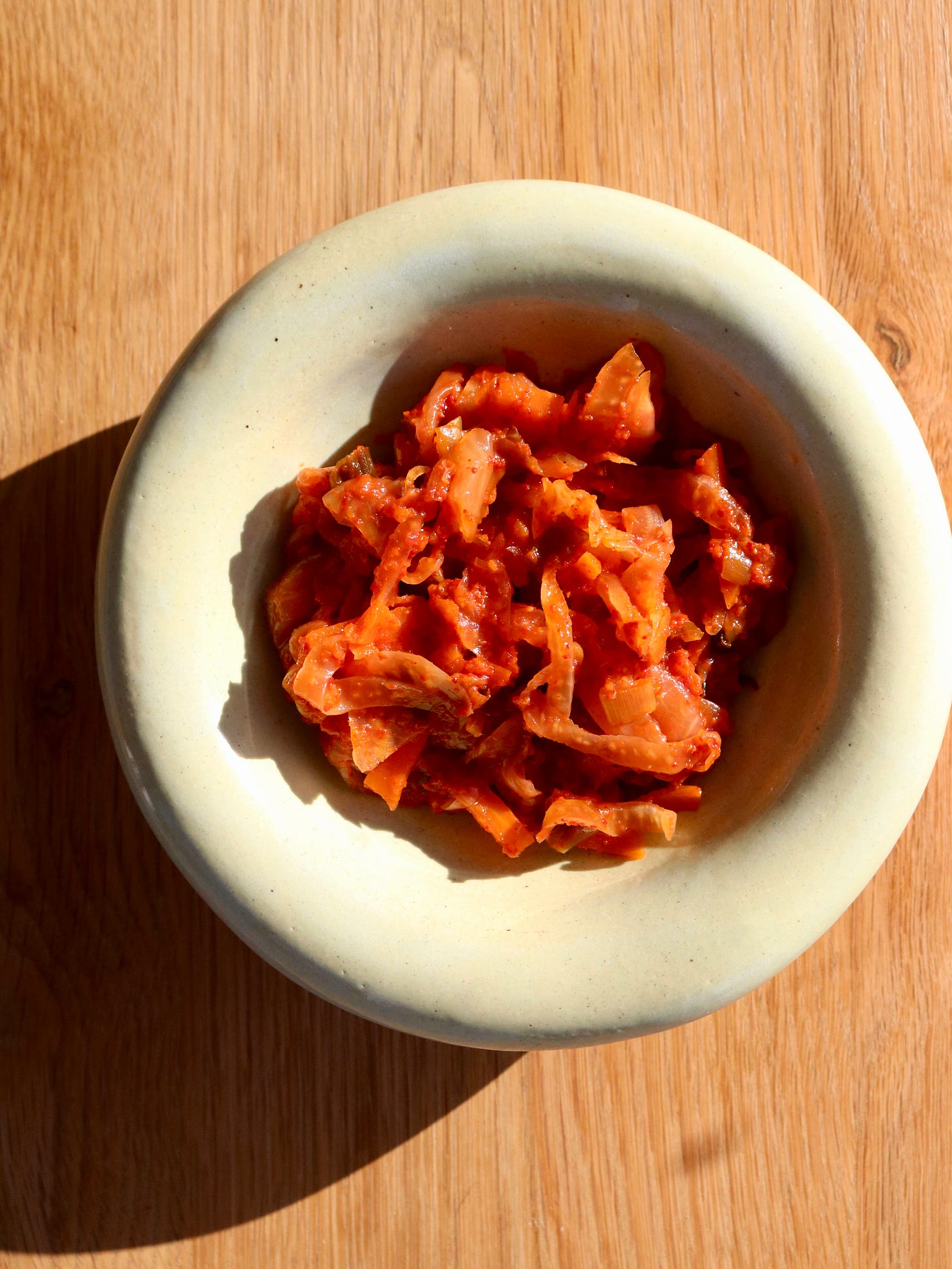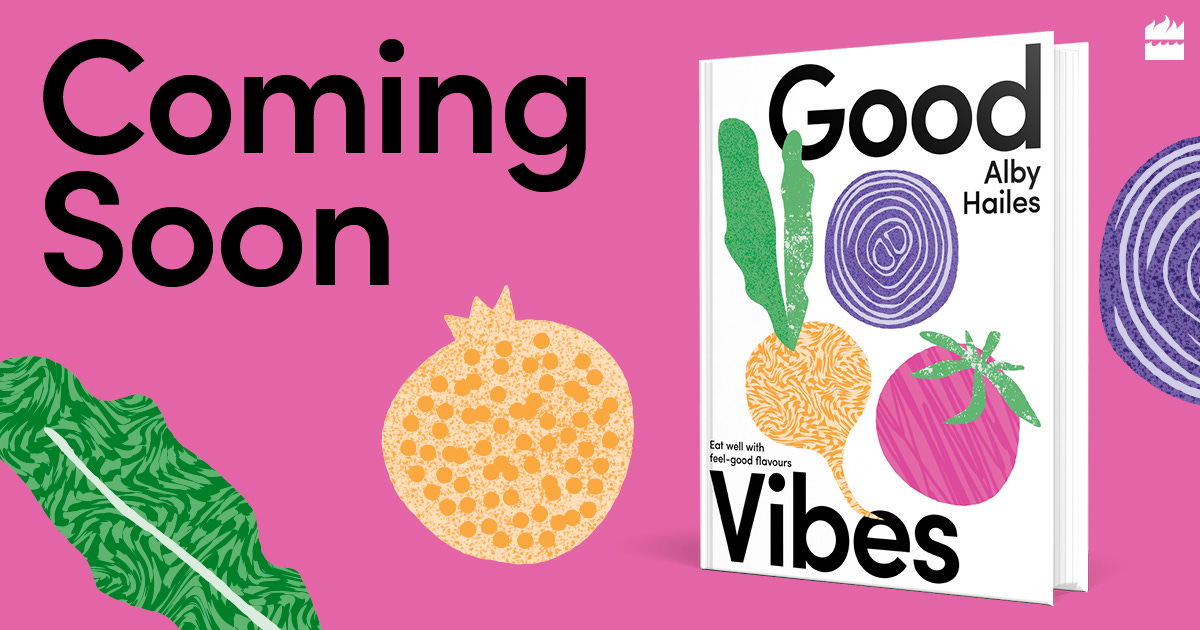Fearless with Flavour #4 - kimchi
A deep dive into the Korean fermented flavour bomb - including a recipe to make your own at home!
Kia ora friends,
First up, I wanted to say the biggest thank you to everyone for your support of my upcoming cookbook, Good Vibes: Eat well with feel-good flavours!! It’s been super humbling to see people pre-ordering the book in anticipation of the August release. If you’re wanting Good Vibes in your kitchen, hit the image below to pre-order your copy now 🥳
This week sees the fourth instalment of my Fearless with Flavour series, and this time, we’re heading back to Korea to talk all things kimchi!
Most of you will likely be familiar with this fermented cabbage condiment, a traditional staple of Korean cuisine (dating back as far as late BC/early AD) and becoming increasingly ubiquitous in the modern global café/restaurant scene. But for those who are new to the kimchi game - what is it, and why am I so excited about it?!
Kimchi is made through the fermentation of salted cabbage (traditionally Napa cabbage is used - a type of Chinese cabbage). Carrot or daikon radish is often included in the mix, as are flavour-boosters like garlic, ginger and gochugaru (Korean chilli flakes - which can be found at all Asian food stores - that give the kimchi its signature red colour and chilli flavour). Kimchi is made through the process of lacto-fermentation, where lactobacillus bacteria converts the sugars in food to lactic acid. If done in a salty and anaerobic environment, growth of other undesirable bacterias is prohibited, and the result is funky, delicious-tasting fermented food that’s good for your gut health too, through its probiotic effects.
While kimchi is traditionally made in onggi (Korean earthenware), it’s remarkable easy to make kimchi in the comforts of your home kitchen with everyday tools and ingredients. Or if you’re feeling extra about your kimchi making, apparently there are even modern kimchi refrigerators specially designed for the making/storing of kimchi. Scroll down below to my Mood Booster recipe that demonstrates how to make your own kimchi at home. Not to fear though, for those who feel you don’t have the time or energy to make your own kimchi (although I highly recommend it for how much cheaper it is), most supermarkets in Aotearoa stock ready-to-eat kimchi in jars in the refrigerated section - usually near the tofu products or pesto etc. which is great to have on hand in your fridge for an on-demand flavour hit.
So now we all know what kimchi is - how on earth do we use it? In Korean culture, kimchi is often served as a side dish at meal times, adding an instant flavour boost alongside any meal. I recently introduced a friend of mine to kimchi for the first time, and she was quick to exclaim that it would go excellent with a cold beer - and this couldn’t be truer (think Korean fried chicken, kimchi and beer on a Friday night - sounds good right?). It’s great with eggs on toast to make an ordinary breakfast a little bit extraordinary; delicious tossed through noodles as part of a quick stir-fry; or if you’re feeling brave, add some kimchi to your next boozy brunch in the form of a spicy kimchi Bloody Mary. Kimchi is great with most things - and if you make your own, you can also control the chilli heat level to match your personal preference.
This week, I thought I’d share with you a few of my favourite ways to use kimchi to add maximum flavour as part of a speedy, warming and filling dinner. On a recent trip to stay with a friend in Wanaka, they made a soup that used bulgur wheat, which gave it a brilliant heartiness that I particularly enjoyed. This inspired one of my favourite soups I’ve made in recent times, and here is the recipe to my Kimchi, peanut + bulgur soup. The kimchi gives the soup incredible depth of flavour and warmth, while the crunchy peanut butter adds subtle crunch and the bulgur brings the heartiness. Perfect for the winter nights that are beginning to arrive.
I'm yet to find someone who doesn't love a good fried rice - and adding kimchi is an easy way to level-up your fried rice game to new heights. My recipe for Kimchi + pineapple fried rice sees caramelised pineapple and umami kimchi kick through this easy one-pan favourite, delivering a delicious flavour hit. It’s a great way to use up leftover rice from the night before, and you can easily swap out the veg for whatever quick-cooking option you have on hand in your fridge/freezer.
For the meat-eaters amongst you, kimchi goes particularly well with pork, and a perfect example of this is my recipe for Kimchi + gochujang meatballs which has featured in the newsletter previously. A fiery spin on your classic spaghetti and meatballs, using kimchi and udon noodles.
Make sure you scroll down further for my easy homemade kimchi recipe - I hope that you’re feeling inspired to try and use kimchi in your home kitchen in the coming weeks!!
Much love,
Alby xx
This week’s MOOD BOOSTER
Pear + fennel kimchi
This is my spin on homemade kimchi, which sees flavours of pear and fennel mingle with more traditional ingredients for a kimchi that delivers in all the flavour departments. Feel free to use this recipe as a base for your own versions - e.g. swap the fennel for some daikon, or try beetroot instead of pear. Clean glass jars are fine - you don’t need a sterilised jar, as you want some bacteria around for the fermentation process. If you can’t find Napa cabbage, using regular green cabbage is perfectly acceptable.
Ingredients:
1kg Chinese leaf (napa) cabbage, outer leaves removed
2 tbsp sea salt
50g garlic cloves (about 2 regular bulbs worth)
50g ginger, peeled and roughly chopped
50g finely chopped onion (about ½ medium brown onion)
50g gochugaru
50ml gluten-free light soy sauce
2 spring onions, sliced into 5mm rounds
1 medium fennel bulb, including fronds
1 medium carrot, peeled and cut into thin 3cm-long matchsticks
1 medium Beaurre Bosc pear, cored and cut into thin 3cm-long matchsticks
Method:
First prepare the cabbage. Cut the cabbage lengthwise into quarters, then coarsely shred each quarter into 5cm-thick strips. Place the cabbage in a large bowl, add the salt, and using your hands squeeze/scrunch the salt into the cabbage leaves. Set aside for 2 hours to allow the salt to draw some of the water out of the cabbage.
When the cabbage is almost ready, prepare the remaining ingredients. In a tall jar using a stick blender, blitz together the garlic, ginger and onion to form a paste. Add the gochugaru, soy sauce and 200ml cold water and blitz together until smooth.
To prepare the fennel, remove the fennel fronds from the bulb and set aside. Slice the bottom off the fennel bulb and using a mandoline, shave the fennel from the bottom to the top into very thin 1-2mm slices. Finely chop the fennel fronds. Place the shaved fennel and chopped fronds in a large bowl. Add the spring onion, carrot and pear, tossing to evenly combine.
To make the kimchi, take handfuls of the salted cabbage and squeeze out as much liquid as you can, then add the drained cabbage to the other vegetables. Pour the red gochugaru sauce over the vegetables and mix well to combine and evenly coat. Pack the kimchi firmly into large clean glass jars (or a fermenting pot), packing down the vegetables firmly to release some liquid to submerge the cabbage fully (I like to use a pestle from a mortar and pestle to do this). Leave a 3cm gap at the top of each jar (for some of the fermenting air to go), screw on the lids and place on your benchtop out of direct sunlight. Leave to ferment for about 2 weeks. Taste the kimchi and when you’re happy with the tang, refrigerate to slow the fermenting process and then use as needed. The kimchi can be stored in the refrigerator and happily eaten for 3-6 months.
Best of the season this fortnight (NZ)
Lemons
Apples
Kiwifruit
Limes
Pears
Late mandarins
Broccoli
Celery
Brussels sprouts
Early yams
Kitchen music of the moment
It seems to be trending right now in the music streaming world (and I’m not certain why given it’s off his 2017 album), but it’s hard to not like this tune Brazil by British singer-songwriter Declan McKenna, written back in 2014 in protest of the 2014 FIFA World Cup.
And throwing it back to a classic, I’ve been jamming some Motown recently in the form of The Supremes. It’s hard to go past the popular Stop! In The Name Of Love.
Interesting reads
A recent article I wrote for RNZ, exploring some of the science behind our favourite comfort foods - and why it’s okay to eat your feelings sometimes
A recent birthday present from my brother I’m starting to read, for those interested in considering how changes in farming could protect our planet and future food security
The Ockham New Zealand Book awards were recently held, check out the winners here, including the beautiful cookbook Kai, by Christall Lowe
Here’s the recipe for the Annabel Langbein soup my friend made in Wanaka - very delicious, with big lemon and mint flavour








